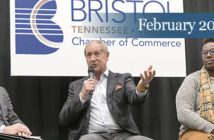By Jeff Keeling
His bosses on the Johnson City Commission were discussing potential shared economic development projects with Washington County, TN last month when City Manager Pete Peterson broadened the scope of the regionalism discussion. The five commissioners, mulling the possibility of an interlocal agreement with Washington County, had mentioned incentivizing retail development in Boones Creek, or possibly beginning to construct a new industrial park in Gray.
If you really want to make an economic development impact, Peterson told the group, you should consider doing something out at Tri-Cities Regional Airport. Peterson has previously said that despite his theoretical support for regionalism, he will fight tooth and nail to keep Johnson City the dominant retail market in the Tri-Cities. Such a position makes complete sense in the short term, given Tennessee’s high sales tax rates and lack of a state income tax. Yet here Peterson was, asking city commissioners to entertain the notion of, first, becoming sufficiently harmonious with county commissioners to agree on how to invest in the future, and second, suggesting a good conclusion would be to invest in a completely different county.
Here’s the rub: Peterson is right. For our local governments to continue pursuing short-sighted goals such as retail recruitment just increases the odds that the pie we’re all fighting over won’t be getting bigger anytime soon. I’ve got news for you, local elected officials. Those retailers you’re considering courting with public tax dollars aren’t going to come here based on the sweeteners you offer – free land or infrastructure, TIF, fancy presentations at the next International Conference of Shopping Centers event. They’ll listen and smile. They’ll take your incentives, don’t get me wrong. But they’ve got algorithms and demographic data and number-crunching capabilities that would make your head spin, and when it comes down to it, until your metro area reaches a certain demographic threshold, they ain’t comin’. And once it does reach that threshold, for the most part, the pittance you’re throwing their way is just gravy, albeit gravy they’ll gladly consume.
Far better, then, that we invest our local public funds in preparing more of our youngsters with the ability to construct algorithms and conduct number-crunching and analyze demographics, among other skills. Such investments help prepare the kind of workforce that can attract new jobs, which can move our region toward the demographic thresholds those retailers are looking for, thus enlarging the pie. If more Tri-Citians have good jobs, more money cycles around the regional economy, the overall metro’s retail sales increase, and everyone wins eventually.
Far better, too, that we invest in the most sensible places to grow jobs, regardless of exact location. Peterson didn’t back away from his premise when I contacted him Oct. 1, saying the individual governments within the region are going to prosper or not prosper together. Those governments co-own the airport, where right now (see story starting on page 18) TCRA has graded 21 acres of 160 total that are envisioned as a regional business/industrial park.
Peterson called that, “probably the prime project that all the local governments ought to get behind for a couple reasons.” He said it likely will bring new aerospace/aeronautics industry into the region beyond Bell Helicopter, which already is here. It helps solidify the airport’s business model by giving TCRA a revenue stream it has never had before. And it holds the possibility of creating hundreds, maybe thousands, of jobs for local residents.
The airport site, Peterson said, is as close to a readily developable megasite as there is in Northeast Tennessee, with utilities already in place. Having an airport of TCRA’s caliber is among the region’s single most important economic development tools local communities have. All the local governments have made investments within their own communities, Peterson said. Now, all of them investing public money into airport growth and job creation would be a great goal, he added.
As Scott Robertson’s article on TCRA this month points out, the airport is pursuing every possible avenue for grants that would help grade the rest of the site’s acreage. It’s time for our local governments, cash-strapped as they may be, to put their heads together and look at innovative ways to prime the pump.




